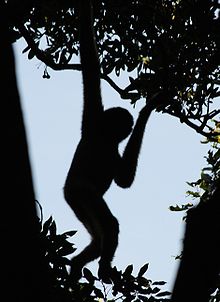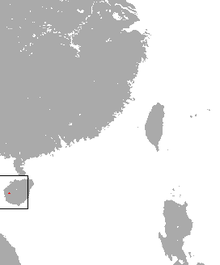- Hainan black crested gibbon
-
Hainan gibbon[1] 
Nomascus hainanus Conservation status Scientific classification Kingdom: Animalia Phylum: Chordata Class: Mammalia Order: Primates Family: Hylobatidae Genus: Nomascus Species: N. hainanus Binomial name Nomascus hainanus
(Thomas, 1892)
Hainan Gibbon range The Hainan Black Crested Gibbon or Hainan Gibbon (Nomascus hainanus), is found only on Hainan Island, China. It was formerly considered a subspecies of the Eastern Black Crested Gibbon (Nomascus nasutus) from Hoa Binh and Cao Bang provinces of Vietnam and Jingxi County in Guangxi Zhuang Autonomous Region, China. Molecular data, like morphology and call differences, suggests it is a separate species [3]. Its habitat consists of broad-leaved forests and semi-deciduous monsoon forest.[4]
The Hainan Gibbon lives in small family groups with a breeding male, two mature females, and their offspring. One offspring is usually born to each breeding female every 2–3 years. After two years it is usually weaned off its mother. It feeds on ripened sugar-rich fruit such as Ficus spp. and, at times, leaves, and insects.[4]
The Hainan Gibbon is one of the most critically endangered primates. In the 1960s much of Hainan's lowlands was deforested to make way for rubber plantations, causing a dramatic decline in the gibbon population, forcing the gibbon community to higher elevations. As of January 2011[update], there are 22 Hainan gibbons- split into two families of 11 and 7 members respectively, with 4 loners, all residing in Bawangling National Nature Reserve on Hainan Island.[5]
Physical characteristics
There is distinct sexual dichromatism in the Hainan Gibbon.[4] The males are all almost completely black, with sometimes white or buff cheeks. Females, on the other hand, are a golden or buff color with black patches, including a streak of black on the head.[4] Both males and females are slender, with long arms and legs and no tail.[4] The arms are used to swing from tree to tree, which is known as brachiation. The Hainan Gibbon sings duets for bonding and mating.[4]
References
- ^ Groves, C. (2005). Wilson, D. E., & Reeder, D. M, eds. ed. Mammal Species of the World (3rd ed.). Baltimore: Johns Hopkins University Press. pp. 180. OCLC 62265494. ISBN 0-801-88221-4. http://www.bucknell.edu/msw3/browse.asp?id=12100781.
- ^ "Nomascus hainanus". IUCN Red List of Threatened Species. Version 2011.1. International Union for Conservation of Nature. 2008. http://www.iucnredlist.org/apps/redlist/details/41643. Retrieved 30 August 2011.
- ^ Roos et al.. > "molecular systematics of Indochinese primates". http://www.primate-sg.org/PDF/VJP1.1.indochinese.systematics.pdf>.
- ^ a b c d e f "Black-crested gibbon (Nomascus concolor)". ARKive. http://www.arkive.org/black-crested-gibbon/nomascus-concolor/info.html. Retrieved 2009-08-01.[dead link]
- ^ "Last-Ditch Effort to Save Embattled Ape". Science. 28 January 2011. http://www.sciencemag.org/content/331/6016/390.summary. Retrieved 2011-02-19.
External links
Categories:- IUCN Red List critically endangered species
- Mammals of Southeast Asia
- Mammals of China
- Fauna of Vietnam
- Gibbons
Wikimedia Foundation. 2010.

